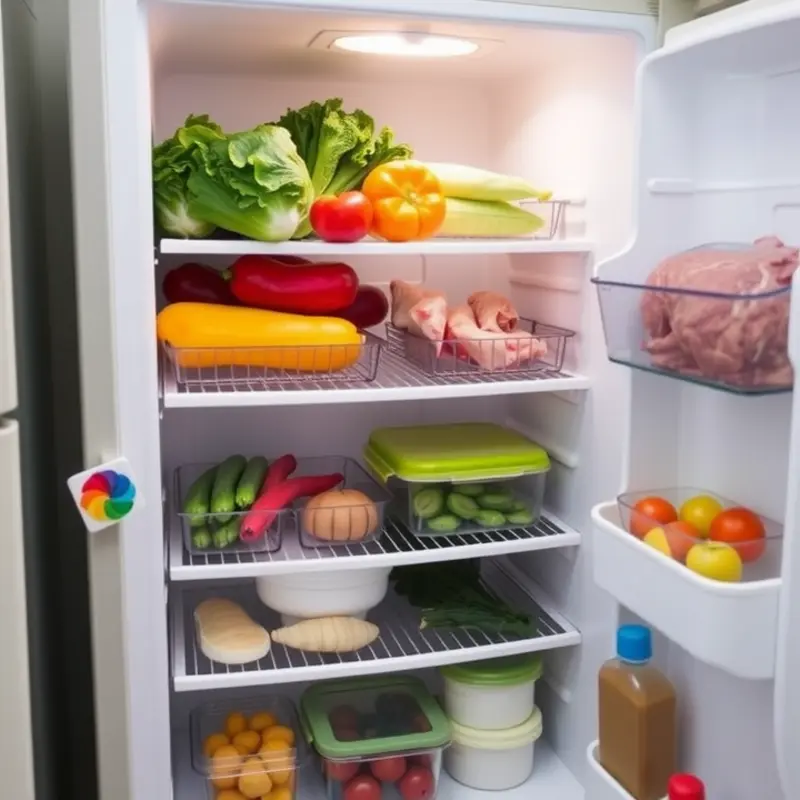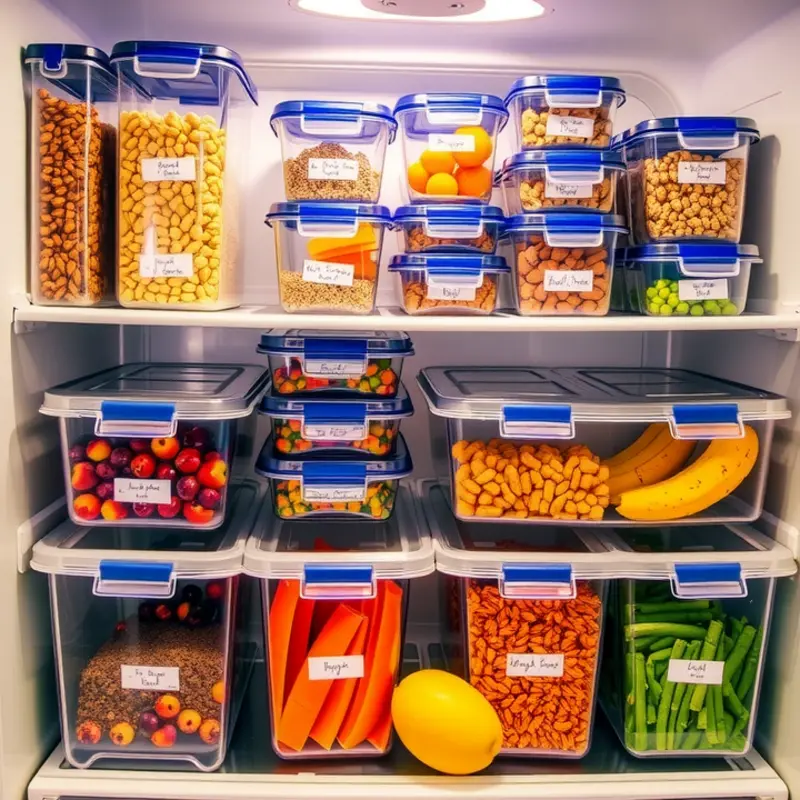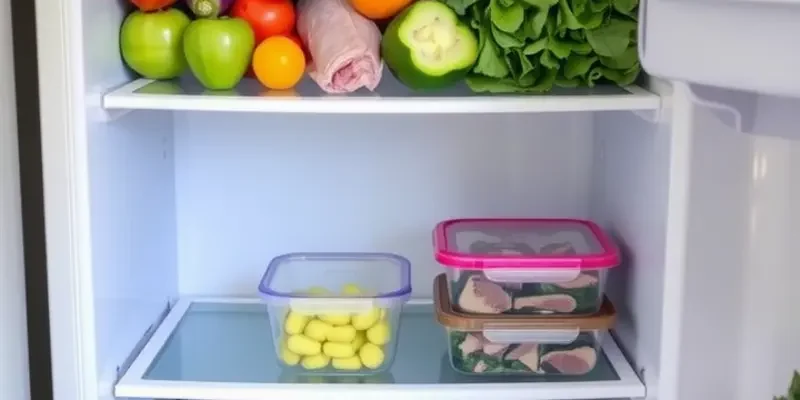Ah, the apartment fridge. One minute it’s a pristine little kingdom of organized snacks, and the next it’s a cluttered labyrinth of mystery leftovers and half-empty condiment bottles. If you’re a young renter, navigating life with roommates, couples, or even a cheerful family, you probably know the struggles of keeping cool in the kitchen. But fear not! With a sprinkle of creativity and a dash of humor, we’re here to turn your fridge into the zen zone of your culinary adventures. Whether you’re storing a week’s worth of meal prep or trying to find a hidden avocado under that pile of takeout, these tips will help you create a fridge that’s not only functional but also enjoyable to dive into, every time. So, grab your organizational tools and a snack (make sure you know where it is!), and let’s dive into the delightful world of fridge organization.
Fridge Fundamentals: The Essential Zones

A well-organized fridge not only ensures food safety but also streamlines meal prep. The secret is effective zoning, which involves assigning specific areas for different food types. This approach maximizes both efficiency and convenience, keeping your ingredients fresh and easy to access.
The Upper Shelves: Ideal for ready-to-eat foods, the top shelf should be reserved for leftovers, beverages, and herbs. These items don’t need cooking, so their elevated position makes them quick to grab. Using clear containers for leftovers is a great visual reminder of their contents and expiry dates.
The Middle Shelves: Dairy products thrive here, where the cool, constant temperature ensures freshness. Store milk, yogurt, and cheese at a comfortable height. Eggs, if not in a dedicated compartment, can also reside here. This level provides a central, easily visible spot that reduces the risk of ingredients being forgotten.
The Lower Shelves: These sections are inherently cooler, making them ideal for raw meats, poultry, and fish. For safety, place them in leak-proof containers to prevent cross-contamination. Keeping these proteins low minimizes accidental drippings on other foods.
Drawers for Fruits and Vegetables: Two separate crisper drawers are key. Set one drawer to high humidity for leafy greens and other vegetables. Fruits, which require less humidity, go in the other. This division helps maintain the ideal balance of moisture, prolonging produce freshness.
The Fridge Door: The least stable in temperature, the door is perfect for condiments, juices, and other items resistant to spoiling. While many fridges include a space for eggs here, it’s best to store them on a middle shelf to maintain a constant temperature.
Organizational Extras: Utilize labeled bins for snacks and deli items, placing them on the middle or upper shelves to encourage healthy snacking and easy access. Consider a tactical rotation system—older items up front, newer ones pushed back—to minimize waste.
Building a habit of routine fridge checks aligns with broader efforts to manage small apartment living effectively. This attention to detail reflects principles discussed in making compact spaces feel bigger (https://borntolease.com/living-lifestyle/making-small-apartments-feel-bigger/) by maximizing efficiency. A neat fridge cultivates a seamless cooking environment and contributes to a more organized kitchen space.
Embrace these fridge fundamentals, and you’ll simplify meal preparation while extending the shelf life of your groceries. Each zone’s role, tailored to specific needs, turns your fridge into a master tool for meal-time magic.
The Art of Storage: Containers and Labels

Imagine opening your fridge and immediately spotting what you need without having to sift through chaotic shelves. The magic lies in mastering the art of storage using containers and labels—a game changer for your kitchen experience. The right storage solutions not only help keep your ingredients fresh, but they also make your cooking process more efficient.
Storing food in clear containers allows you to see what you have at a glance. Choose stackable options to maximize vertical space, which is often the most underutilized in fridges. Opt for modular designs that fit snugly into your fridge layout, preventing any wasted space. Being able to quickly identify what’s inside each container eliminates needless rummaging, saving you both time and effort.
Consider airtight containers for items that need to stay crispy or retain moisture, such as leafy greens or pre-cut fruits. For fridge staples like milk or leftover sauce, try containers with measuring markings. This handy feature helps you avoid those last-minute cooking surprises when you realize you’re a cup short.
Labels are your secret weapon for maintaining order. Think of them as the finishing touches that make your fridge sing with harmony. Use waterproof labels for marking containers, so spills can’t compromise their legibility. Chalkboard stickers or erasable labels are excellent for items that frequently change, like leftovers or meal preps. This flexibility means your labeling system can adapt with your evolving fridge contents.
To keep your fridge contents accessible, categorize items by using dividers within larger containers or bins. Group fruits, veggies, and dairy separately to simplify meal preparation. This strategy not only enhances organization but also prolongs the lifespan of your groceries. It’s a smart way to minimize waste, creating a habit that’s as sustainable as it is practical.
Incorporating a robust system of containers and labels isn’t just about aesthetics, but about efficiency in a constrained space. A well-organized fridge is an extension of a well-organized lifestyle. As a renter, you can apply similar strategies to other areas of your apartment, such as using DIY renter safe kitchen hooks to keep cooking utensils accessible but out of the way.
Investing time in arranging your fridge can be therapeutic, much like a mini-makeover for your kitchen. The satisfaction of knowing precisely where each ingredient lives infuses a sense of control and calm into daily routines. It’s these subtle transformations that bring joy into day-to-day living.
As you embrace the art of thoughtful storage, remember it’s about making your life easier. With a bit of creativity and the right tools, your fridge can become the unsung hero of your apartment.
Final words
Voilà! You now have the tools to whip your fridge into shape, turning it into a space that brings joy, ease, and delicious meals to apartment living. With clearly assigned zones and stylish storage solutions, rummaging for snacks or wondering what’s for dinner will be a thing of the past. Embrace the organized life, whether you’re a solo snack ninja or running a chaotic family kitchen. Your future self (and your leftovers) will thank you for it. Now, go bold with colorful labels and get creative with your meal prep—but should we take a poll on that ancient yogurt in the back? Let’s clean out the old and make room for the new. Here’s to your fridge’s shiny new chapter!









